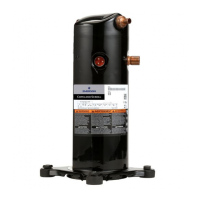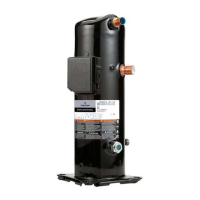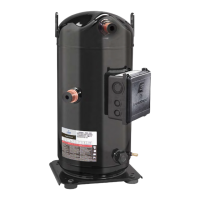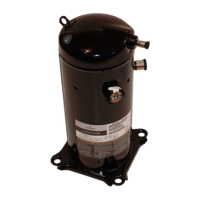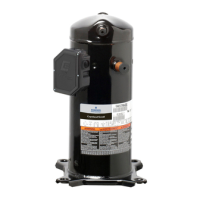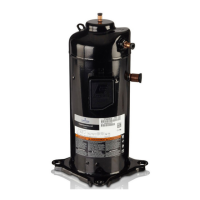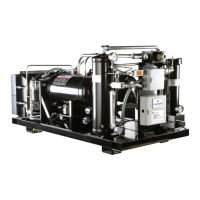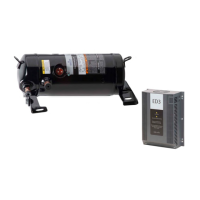5
© 2015 Emerson Climate Technologies, Inc.
AE4-1400 R1
protection for the highest level of system protection.
The low pressure cut-out can provide protection against
indoor blower failure in cooling, outdoor fan failure in
heating, closed liquid or suction line service valves, or
a blockedliquidlinescreen, lter,orice, or TXV.All
of these can starve the compressor of refrigerant and
result in compressor failure. The low pressure cut-out
should have a manual reset feature for the highest
level of system protection. If a compressor is allowed to
cycle after a fault is detected, there is a high probability
that the compressor will be damaged and the system
contaminated with debris from the failed compressor and
decomposed oil. If current monitoring of the compressor
is available, the system controller can take advantage of
the compressor TOD and internal protector operation.
The controller can lock out the compressor if current draw
is not coincident with the contactor energizing, implying
that the compressor has shut off on its internal protector.
This will prevent unnecessary compressor cycling on a
fault condition until corrective action can be taken.
Heat Pump Protection
A low pressure control is highly recommended for loss
of charge protection and other system fault conditions
that may result in very low evaporating temperatures.
Even though these compressors have internal discharge
temperature protection, loss of system charge will
result in overheating and cycling of the motor overload.
Prolonged operation in this manner could result in oil
pump out and eventual bearing failure. A cut out setting
no lower than 20 psig (1.4 bar) is recommended.
Operation near -25°F (–32°C) saturated suction
temperature is clearly outside the approved operating
envelope shown in Figure 1. However, heat pumps
in some geographical areas have to operate in this
range because of the low ambient temperatures. This
is acceptable as long as the condensing temperature
is not above 90°F (32°C) and the resulting discharge
temperature is below 275°F (135°C). Some liquid
oodback to the compressor under these conditions
can help keep the discharge temperature under control.
Discharge Line Thermostat
Some systems, such as air-to-air heat pumps, may not
work with the above low pressure control arrangement.
A discharge line thermostat set to shut the compressor
off before the discharge temperature exceeds 260º
F (125ºC) may have to be used to achieve the same
protection. Mount the discharge thermostat as close as
possibletothecompressordischargettingandinsulate
well. See Table 5 for recommended Emerson Climate
Technologies part numbers.
Air Conditioning Unit Protection
Air conditioning units can be protected against high
discharge temperatures through a low pressure control
in the suction line. Testing has shown that a cut out
setting of not lower than 55 psig (3.8 bar) will adequately
protect the compressor against overheating from the
aforementioned loss of charge, blower failure in a TXV
system, etc. A higher level of protection is achieved if
the low pressure control is set to cut out around 95 psig
(6.7 bar) to prevent evaporator coil icing. The cut in
setting can be as high as 180 psig (12.5 bar) to prevent
rapid recycling in case of refrigerant loss. If an electronic
controller is used, the system can be locked out after
repeated low pressure trips.
High Pressure Control
If a high pressure control is used with these
compressors the recommended maximum cut out
setting is 650 psig (45 bar). The high pressure control
should have a manual reset feature for the highest level
of system protection. It is not recommended to use
the compressor to test the high pressure switch
function during the assembly line test.
Shut Down Device
ZP*K6 compressors employ a unitary shutdown device
to manage the ow of top-cap discharge gas back
through the scrolls after shutdown. Development testing
should include a review of the shutdown sound for
acceptability in a particular system.
Discharge Check Valve
A low mass, disk-type check valve in the discharge
ttingofthecompressorpreventsthehighside,high
pressure discharge gas from owing rapidly back
through the compressor after shutdown.
Motor Overload Protection
Conventional internal line break motor overload
protection is provided. The overload protector opens the
common connection of a single-phase motor and the
center of the Y connection on three-phase motors. The
three-phase overload protector provides primary single-
phase protection. Both types of overload protectors
react to current and motor winding temperature.
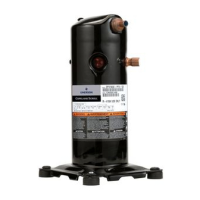
